
Food GPS has an interesting Q & A-style interview with the founder of Lagunitas Brewing, Tony Magee. I’ve known Tony since shortly after he started his brewery and he’s one of may favorite people in the industry. Check out the Q&A with Lagunitas founder Tony Magee.
Yuengling Talks To The Wall Street Journal

With the announcement that Yuengling Brewery is buying their fourth brewery to continue to expand their market, the Wall Street Journal today has a nice overview of the company’s plans for the future. Check out After 181 Years, Local Beer Stops Playing Hard to Get.
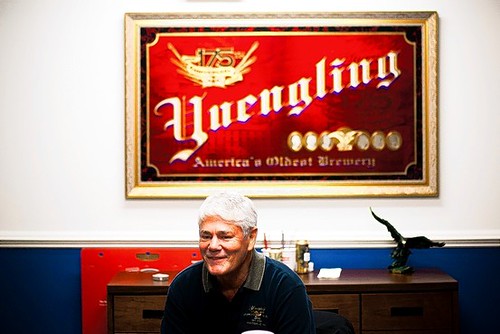
Dick Yuengling (Photo by Scott Lewis)
The Celebrator’s Conversation With Ken Grossman

Tom Dalldorf did a great interview with Ken Grossman of Sierra Nevada Brewing for the most recent issue of the Celebrator Beer News. The new issue features part of the interview and also Grossman on the cover for Sierra Nevada’s 30th anniversary this year.

The entire interview is just under 30 minutes and was done last month in Chico. Enjoy.
A Conversation with Ken Grossman from Wing and Wing Productions on Vimeo.
Fritz Maytag & Keith Greggor Talk About Anchor On PBS

This morning on KQED, San Francisco’s PBS station, aired a live interview with Fritz Maytag and Keith Greggor about the sale of Anchor Brewery. The podcast of the interview, Anchor Steam Sold, is now up and you can listen to it on the KQED Archive or download it for you iPod. Or you can just push the play button below.
My Lunch With Keith Greggor, New Anchor Owner

I got a call yesterday morning from John Dannerbeck, CEO of Anchor Brewery, who let me know the details about the sale of Anchor and also conferenced in Keith Greggor, the CEO of the Griffin Group, the entity that’s entered into an agreement to buy the brewery. Since he’s essentially a neighbor, we met up for lunch at a bar in downtown Novato to talk.
We met about Noon, and shared a BrewDog Dogma, their 7.8% beer brewed with Scottish heather honey, poppy, kola nut and guarana. Greggor himself was laid back, dressed casually and had kept his British accent nearly intact, despite living in the states for over 25 years, having become a U.S. citizen nearly ten years ago. Greggor, I learned, was born in Bournemouth, on the southern coast of England. When he was nine, he moved to Singapore and began dreaming of one day living in San Francisco. That would take another thirty years to come true, as he returned to the UK for college and then joined IDV (International Distillers & Vintners) in London in 1983. IDV eventually became part of Diageo, owners of Guinness, among much else.
In 1985, Greggor moved to New Jersey, where he took a job with one of IDV’s US companies, the Paddington Corporation. There he met Tony Foglio, originally from Brooklyn, and the pair worked together at Paddington until 1998, when they left as Diageo became less fun and assumed more of a corporate culture. They took over management of Skyy Vodka and increased the company tenfold, before completing a long process whereby the Campari Group acquired an ever larger stake in Skyy, eventually taking over control of the company in 2007. Greggor formed the Griffin Group the same year, and Foglio joined him last year.
In October of 2008, the Griffin Group bought Preiss Imports, an importer of mostly spirits in southern California. They do carry two beer brands, and that’s how I knew Henry Preiss, who called on me when I was with BevMo about their Australian beer, Cooper’s. The other brand they recently undertook is BrewDog. The first week after acquiring Preiss, Greggor met James Watt from BrewDog and the pair hit it off, with Watt coming to Greggor for business advice. When it came time for BrewDog to expand in June of last year, the Griffin Group became a minority investor in the Scottish brewery.
According to Greggor, about nine months ago they began talking to Fritz Maytag about an idea they had for a “Center of Excellence” in San Francisco which he describes as an “epicenter of development, education, entertainment and innovation, all designed to further contribute to the culture and heritage of craft beer and artisan spirits.” Given the disproportionate attention paid to wine in northern California, I’d certainly love to see something focused on beer and spirits in the region, too. So they kept talking to Fritz off and on, he checked them out, and they kept talking. Eventually, they reached an agreement whereby Maytag would sell the brewery and distilling operations to them, and the deal is expected to close at the end of June.
The current employees will all remain and nothing much should change around the brewery at all. John Dannerbeck, current president, will continue in that role, reporting to Greggor after the close. Foglio will then become chairman, and Maytag will remain involved as chairman emeritus. The only changes will likely be in marketing. Additional sales people will be hired and will represent the Anchor, BrewDog and Cooper’s brands. Greggor sees lots of opportunities to grow the brand, and that’s really he and Foglio’s specialty.
While no new brands are planned, they are open to that possibility but are adamant about not messing with the current lineup. If anything came through loud and clear, it’s that they’re nearly as passionate as Fritz about protecting the Anchor brand. And that makes sense, frankly, as their careers have been devoted to building up brand names. Greggor told me he plans on doing a lot of listening, finding out how things work and why. There’s a lot to learn, he said, and I think fans can rest assured that the brand will be in good hands that have no intention of messing about with it.

Tony Foglio, Fritz Maytag and Keith Greggor in the Anchor Brewhouse.
The only foreseeable changes are things like their recent announcement that Humming Ale, previously available only on draft, will be bottled this summer. There’s also a possibility that Martin Dickie, BrewDog’s brewmaster, may brew some of his beers at the Anchor Brewhouse, but that probably won’t happen for a while.
I finally got around to finding out about the way in which the news came out on Monday, and it turns out it was as much of a surprise to both Anchor and the Griffin Group as everyone else. Apparently what happened was an embargoed press release was given to a few mainstream media outlets. An embargoed press release is common practice for certain types of events. In effect, news outlets get the news early under strict orders not to release the information until a specific date in the future. In this case, the news of Anchor’s sale should not have been announced until the next day. It’s done for things like presidential speeches, where a copy of the speech itself is given to the press early so they can begin writing it up in advance. The same thing was done here, but the writer assigned to the story accidentally leaked it. Although a 30-year veteran of reporting, he apparently had little knowledge of the beer industry and reached out to both Beer Advocate and DRAFT for a comment on the story, sending them the embargoed press release in the process. They both promptly posted it. Frankly, I would have probably done the same thing with news that big.
Maytag was in the air when it broke, on his way to a micro-distillers’ conference. At first I thought the employees had not yet been told, but I’ve since learned they did find out from him prior to his trip. But once the news leaked early, nobody was sure what to do, and so they decided to not respond until the next day, when they could figure out how to respond, which left everybody wondering and my phone ringing off the hook. And that’s why I got an e-mail from John Dannerbeck first thing Tuesday morning and talked to him on the phone a little later. They had hoped to manage the news a bit better, but everything went haywire when the news came out the way it did. I’m also told that someone at a news outlet somewhere had some heavy explaining and apologizing to do.
My colleague, Brent Ainsworth, a reporter at the Marin IJ — and fellow Novato neighbor — spoke with Greggor right after we had lunch yesterday, and his interview, Novato man, new co-owner of Anchor Brewing, reflects on deal and beer industry, is up on the IJ’s website.
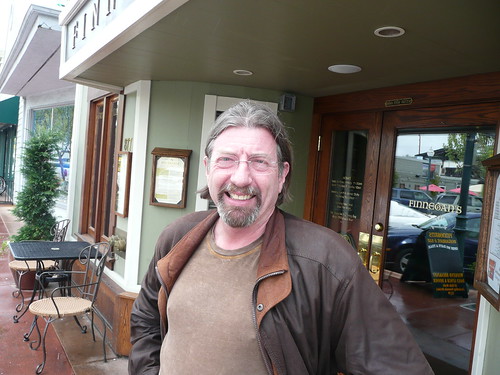
Keith Greggor outside Finnegan’s yesterday in downtown Novato.
UPDATE 4.29: Don Russell talked to Fritz Maytag by phone today, and has a Q&A posted on his Beer Radar that has some more insights into the impetus to sell.
The New Anderson Valley: A Chat With Trey White

Recently it was announced that Ken Allen, who founded the brewery in 1987, is selling Anderson Valley Brewing to Trey White, a former USB executive. The response on the series of tubes we all know and love as the internet was swift and surprisingly negative. Also, there was quite a lot of speculation that was simply untrue. Even the local Anderson Valley Advertiser detailed some of the negative reactions. So I spoke with Trey White this morning to clear up some of the misinformation swirling around and get to the bottom of what he has planned for his brewery when he takes over next month, after the sale closes.
First, the biggest piece of misinformation, which I didn’t even need to talk to him about to correct. A number of negative comments took the form of “how sad, another case of a big business swallowing up a smaller one.” Wrong. White is a former VP with USB. That means he doesn’t work there any more, and in fact hasn’t for several years. I, and most of the accounts that mentioned his former job did so to show that he brings beer industry experience with him. That’s a good thing. It means he knows how the industry works. As I learned when I spoke with White, the business will be family-owned, just White and his wife. No big company in the background, just a mom and pop operation.
Here’s what else I learned about his plans for the brewery. White first visited the brewery three years ago and immediately fell in love with the place. He and Ken Allen have been discussing the purchase for nearly that long. He’s committed to its success and it wasn’t just a quick flash in the pan decision.
White and his wife currently live in downtown Chicago, ironically walking distance from the Craft Brewers Conference which will take place the first week of April. For the first six months to a year after taking over, the Whites will spend about 75% of their time in northern California. All of the current staff and brewers will remain in place and no changes will be made to any of the recipes. The first year, some of the packaging may be changed and it’s possible some additional styles and/or special releases will be created.
The Boonville Beer Festival will be unchanged and the planning for it will continue apace and it will be held, as scheduled, on May 8. The Disc Golf Course will also remain on the brewery grounds.
While the brewery continues to hum along, White will turn his attention to what he knows best: marketing, merchandising and selling. He’ll immediately begin working to increase distribution and get Anderson valley beers into a greater number of chain locations, making it even easier for fans to find the beer in a wider array of outlets.
Ken will be the first to tell you that his passion for the brewery has not been 100% over the last few years and he’s been looking forward to taking a much needed rest from running the business. Ken had this to say, in the press release:
“I have enjoyed immensely growing the Anderson Valley Brewery from a start-up operating a modest brew pub in Boonville into a world class regional craft brewery. The people and friends I have made in the industry will last a lifetime. I want to thank the many customers and brewery fans who have become key parts of the Anderson Valley Brewery family.
I have looked long and hard for the right person to whom to entrust our legacy and I could not have found a better partner in Trey White. His passion and knowledge of the craft beer industry, coupled with his respect for the brands we have developed, will make him the ideal person to take the Anderson Valley Brewery to the next level within the growing craft beer industry.“
So I can’t help but think this will a positive step for everyone, from Ken Allen, the new owners and fans of the brewery’s beers. In talking with Trey White, he has that passion that can propel the brewery to the next level. He seems sincere in his reverence for the brands Anderson Valley has created over the years and has no plans to alter them in any way. He has the right experience and contacts to grow the business successfully while keeping it true to its roots. Let’s wish Ken a happy retirement and Trey good luck with his new job as a small brewery owner.
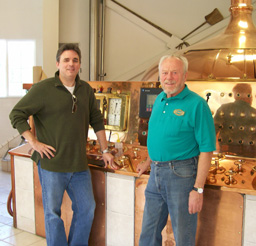
The changing of the guard: new owner Trey White, at left, with founder Ken Allen in the Anderson Valley brewhouse.
Brewers Day Profile: Brian Hunt

Shortly after I launched the website for International Brewers Day, I got an appropriately curmudgeonly comment disdaining the idea from my friend Brian Hunt, who owns Moonlight Brewing. Here’s what he had to say.
Let’s all just make good beer and drink it. The Brewer’s Association will log acres of forests for special posters and mailings. I can see Hallmark jumping on this one big time, and before long you’ll have to wade through all the K-Mart “holiday” ads looking for that right something for the brewers in your life. I vote no on this.
While hardly shy, I think having worked in the moonlight for so many years has made Brian shy away from the limelight. That alone made him the perfect choice for my first IBD profile. He is, to my mind, one of the truly unsung heroes of brewing, quietly making some of the nation’s best beers.
And happily I’m not the only one. In an article entitled Czech Mate, published in Forbes, the author reveals that of all the beers rated on Beer Advocate, Moonlight’s Reality Czech is the only golden lager on their list of the “Top Beers on Planet Earth.” Unfazed, Hunt explains.
“We have almost no concept in this country that we can have a beer that is light but also flavorful and vibrant,” explains Brian Hunt, Moonlight Brewing’s owner (and sole employee). “Making a great lager like that requires more time, more skill and more expense than making an ale.”
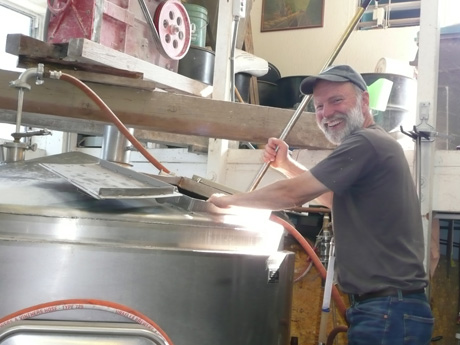
Brian Hunt was, of course, born in a log cabin near Sacramento, and walked ten miles to school, uphill — both ways — through blizzards in winter and punishing heat in summer. Alright, everything in that last sentence, except Sacramento, I made up. But Brian’s past just cries out to be remade as mythic fable.
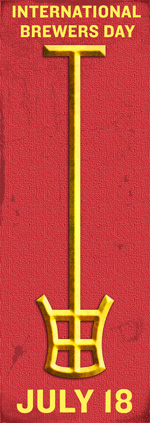
Brian started college at U.C. San Diego as a biochemistry major, but soon realized that most of his fellow students were pre-med, a path he decidedly was not interested in pursuing. So he transferred to U.C. Davis to study fermentation sciences with an eye toward becoming a winemaker. But fate stepped in when he was randomly assigned Michael Lewis as his advisor. Needing income, he found himself working in Lewis’ laboratory and found it was easy to be persuaded to concentrate on beer instead of wine. He found his fellow brewing students much closer to his own temperament, more down to earth and fun. “Beer just seemed more enjoyable.” Hunt remarked.
After graduating with a degree in Fermentation Sciences in 1980, Hunt relocated to the heart of early brewing — Milwaukee, Wisconsin — to take a job at the Schlitz Brewery. He loved the history of the place. Everywhere you looked it was there. Hunt spent about eighteen months working for Schlitz. There were no computers in the place. Every step they took was done manually, so you learned the reason why you did certain things, and you could extrapolate those to subsequent steps, too. As a result, he learned a lot in that year and a half, crediting that experience with setting the tone for the rest of his career.
He moved back to California in 1981, brewing at the now long gone Berkeley Brewing Co., making ales and lagers on a 40-bbl system. After that venture went belly-up, he consulted on several brewing projects throughout the Bay Area, before ending up at Acme Brewing in Santa Rosa, California in 1985. He was there two years, but the brewery never had much of a chance owing to financial issues that the owners had not anticipated. The majestic 100-bbl brewhouse finally made its first batch of beer on March 2, 1987, but it was too late. Hunt says of his time there that it was a great MBA project and he learned most of what he needed (whether he wanted to or not) about the business side of the brewing industry.
When the Santa Rosa brewery finally shuttered its doors, Brian spent some time working for the other team at Grgich Hills Winery before a brief stint formulating two beers (whose recipes have since changed) and helping layout the brewery itself at the early Anderson Valley Brewing Co. in Boonville.
In 1988, Brian finally opened his own place in Napa with a descendant of the Hamms brewing family. He had a 1/3-share of Willett’s Brewing Co. (now Downtown Joe’s) from sweat equity and $1,100 of his own money. But by 1992, a get-rich-quick lawsuit brought by one of the brewpub’s employees forced Willett’s into bankruptcy. Brian Hunt saw the writing on the wall, and when someone phoned him to offer 100 Hoff-Stevens kegs, he bought them for himself and began … well, moonlighting.

The original Moonlight brewery was built in a barn behind the house he was renting. He built the entire system himself using equipment cobbled together from a variety of sources. Brian bought old kettles from a winery that couldn’t boil water, and so had to be adapted. Quite a number of items from Sierra-Nevada’s yard sale (when they opened their own larger brewery in Chico) found their way into Moonlight’s brewery barn, including fermenters and a keg washer. The whole enterprise was financed with credit cards and a $20,000 personal loan. The initial brewhouse included a 7-bbl system.
The original name was going to be Old Barn Brewery, but it never sounded quite right. New Moon Brewing was also an early contender of the hundreds of names that were brainstormed. But once the name Moonlight was floated, there was no turning back. It just worked on so many levels and it seemed to mean different thing to different people, a quality Hunt relished.
For the first two-and-a-half years, beginning in 1992, Brian literally slept 5-1/2 nights out of every seven. He was working two jobs, one at the newly opened Downtown Joe’s (where the bankrupt Willett’s brewpub had been) and at his own place in the barn. This continued until he could afford to concentrate just on Moonlight Brewing. But just a few years into the new venture, another monkey wrench was thrown Hunt’s way. His landlord decided he wanted the house Hunt and his family lived in for his own son and told Brian they had to go. Luckily, they let him keep the brewery in the barn until it could be moved. In 1999, Hunt and his family moved to their present location. It would take another four years until all he permits were in place and the new brewery was built. The new system was 21-bbl and was the original Hart Brewing system, which Brian bought from the Thomas Kemper brewery on Bainbridge Island in Washington. The present set-up has pieces from at least fifty different breweries, either ones that went out of business or upgraded.

Neither the original brewery now the new one has a computer of any kind in it, and that’s by design. It’s because of one of Hunt’s favorite quotes, this one by Albert Einstein. “Imagination is more important than knowledge.” Hunt sees one of the most important aspects of brewing as creativity and thinks of himself more as a tinkerer or toymaker of sorts. And, as he puts it, “you can’t see what’s happening if you’re just pushing buttons.” He believes that many young brewers don’t understand how to make “delicious” because of what he terms “a failure of imagination.” This is because, he says, “many are not taught how to think for themselves.

The first three beers Moonlight brewed are all still being made: Lunatic Lager, Death & Taxes, and Twist of Fate. Lunatic Lager’s original name, though, was Moonlight Pale Lager, so named because Hunt thought it would translate better to consumers already aware of the newly popular pale ales. The fourth beer Hunt made was Bombay by Boat IPA, also in 1992, and it was one of the first IPAs made in America. At that time, nobody really made one and certainly those few who did, did not call it an IPA.
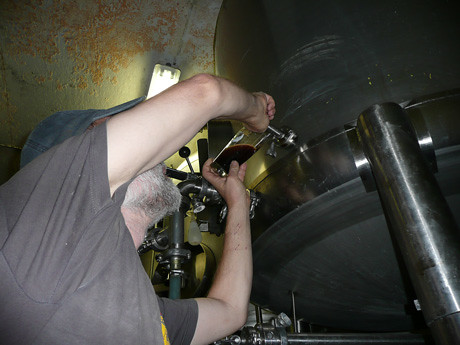
Hunt believes that being small also allows him a flexibility that bigger breweries can only dream about. He can follow market trends and turn on a dime. Because he not only brews the beer, but also delivers it (he’s a one man operation, most of the time) he’s not removed from his customer but mingles and converses with them almost every day of the week.
His original plan was to hope that he could make a living in Sonoma selling whatever he brewed. Though his net is spread slightly wider than he originally thought, it’s not by much, and he’s remained true to initial vision. “I don’t find success by selling a lot, I find it by selling to people who respect it or appreciate it.” So long as that’s the case, we won’t be seeing Moonlight beer in grocery stores nationwide or even bottle locally. Brian’s just not looking for that kind of success. He’s content doing what he wants in his own way, an iconoclast to the end. As you’d expect, Hunt also doesn’t think much of competitions either. “Fame is empty.” He says. “Good beer should not be.” So while that may be a loss for the people who can’t find Moonlight beer in their neighborhood, it does make the Bay Area just that much more of special place for beer and provides yet another reason for beer fans around the world to make the pilgrimage to taste California beer.

Or put another way — as his pint glasses used to read — “good beer is as good beer does.”
Sam Calagione Uncorked

My “Uncorked” interview with Sam Calagione, from the Dogfish Head Brewery, is in today’s San Francisco Chronicle. I’m quite pleased with how it turned out. If you’re unfamiliar with the Uncorked series in the San Francisco Chronicle, they’ve been doing them for some time now, and it’s an interview that begins with some expository background information. They’re meant to be fun and a little thought provoking, with at least a few quirky, off-the-wall questions thrown in for good measure. I read a number of them in preparing my own questions, so I could get the tone right. So when I came up with my questions for Sam, I figured ask far more than I needed so that I could pick and choose the best ones. Sam, of course, is no stranger to public speaking and so made the process much easier. The hard part was choosing what to include and what to leave out. So here are a few more questions and answers from the original interview that I didn’t have the room to include in the Chronicle article.
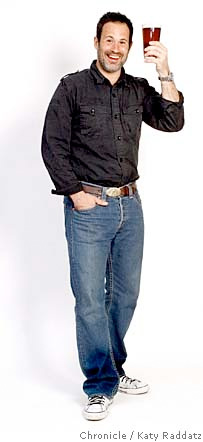
What’s your favorite style of beer for spring?
I would have to say, just IPA. In general, whether it’s a big imperial IPA or a regular one. Those grassy, fruity, estery characters of an IPA remind me of the greening of the trees and the greening of the grass and just nature coming back to life.
Why should everybody in America be drinking craft beer?
Because Americans are starting to trade up and appreciate the finer things and recognizing that instead of a soul-killing SUV or vacation house, that they can spend $10 and get the world’s best beer. The craft beer renaissance is truly an affordable connoisseurship and compared to wine, where the world’s best bottles are going to cost hundreds, if not thousands, of dollars, anybody in America can buy the world’s best beers. And because every American lives within ten miles of their local brewery, it’s not only an affordable connoisseurship but it’s an accessible world, too.
As an Italian-American, what do you think of the recent Italian beer renaissance?
It’s beautiful. It’s just indicative of a culture that embraces the finer things, whether it’s wine, beer or culinary. They got their priorities right over there. It’s about living well and spending time with loved ones and friends around a table full of great food and drink. I think it’s a wonderful sign of the craft brewing renaissance to watch it landing in other cultures that had traditionally been more associated with wine.
Why Did You Choose Delaware?
To be perfectly honest, by the time I got my shit together and raised the money I needed to start it, there were only eight states left in America that didn’t have a brewery. And I thought it would be great marketing cache to be the first brewery in a state and the first brewery in the first state sounded good. My wife, Mariah, who runs the company with me was born and raised in Delaware. So I’d go down and visit her in the summer, and living right on the Atlantic beach seemed pretty cool. I love it, we’re two hours from D.C., Baltimore and Philly, and it’s a great place to live and have a brewery.
What is a Randall?
A Randall is an organicalyptic hop-inducing module. Basically it was an invention we came up with for an east coast vs. west coast beer event, where Russian River Brewing, and some others, brought their beers and at the end of the day the east coast brewers beat the west coast brewers for the best hoppy beers in the country. We’ve now made 300 Randalls, and they’re being used in breweries all around the world. Basically, it’s a glorified, customized pool filter that we load with whole leaf hops and the beer acts as a solvent and strips the oils off the hop leaves and pour them in your glass. It’s just a great tool to educate the consumer on what hops does to beer. Not many consumers see hops changing their beer at the point where they’re actually drinking it, so it’s been a neat educational tool for us.
Do you take a certain pride when brewer’s say about their own beers, “No Randall Required?”
I actually do. Basically, to me, it sounds like insecurity, like maybe they should start thinking about using a Randall.
You’ve done a couple of Rap CDs, the Pain Relievez, with your head brewer Bryan Selders, and on a few songs you taunt West Coast brewers. Are you worried about any reprisals while you’re in town, on their turf, so to speak?
I hope they don’t Tupac my Biggie. It’s all done in good fun and we love those guys. But boy, I hope they bring out a response album, but I don’t think they have the guts or the rhythm.
What did you drink last night?
About 10-12 beers, to be perfectly honest. I was with my good friends that own breweries from around the country and we collectively brewed this gueuze-style beer called Isabelle Proximus. So we ended the night with that, but we enjoyed each others’ beers in all the courses that led up to that. That project is indicative of how altruistic and mutually supportive the craft brewing industry is. It’s an amazingly unique community where we teach each other what we know for the greater good and try and help each other, recognizing that collectively 1450 breweries in America have less than a 5 percent share and three giant ones have over an 80 percent share, but the craft beer [segment] is where the growth is at and it shows that the consumer now understands and appreciates what the small breweries in America are doing.
The rest of the interview can be read in today’s San Francisco Chronicle (page F-3) or online at SFGate.com.
Q&A with Lagunitas’ Tony Magee
The Santa Rosa Press Democrat had a nice interview with Lagunitas Brewing owner Tony Magee a couple of days ago. The piece was called “the art of the brew.” I’ve known Tony for a lot of years and he’s a terrific person who makes some fine beers.

Tony Magee and me at last year’s Bistro IPA Festival.
Goose Island Video Profile
BusinessPOV, a Chicago media enterprise doing online video micro-journalism, contacted me about their latest effort, a video profile of Goose Island Brewing. It includes a short interview with Brewmaster Greg Hall interspersed with footage of the brewery and Goose Island’s beers. It’s a little over five minutes and manages quite nicely to give a good flavor of what their business is all about. It’s definitely worth checking out.
Click above to watch the video profile.
